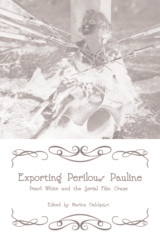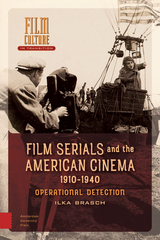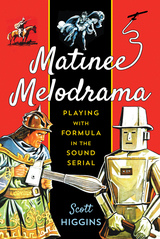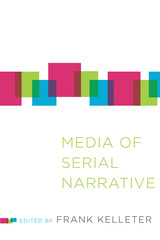4 books about Film serials

Exporting Perilous Pauline
Pearl White and Serial Film Craze
Edited by Marina Dahlquist
University of Illinois Press, 2013
Exceptionally popular during their time, the spectacular American action film serials of the 1910s featured exciting stunts, film tricks, and effects set against the background of modern technology, often starring resourceful female heroines who displayed traditionally male qualities such as endurance, strength, and authority. The most renowned of these "serial queens" was Pearl White, whose career as the adventurous character Pauline developed during a transitional phase in the medium's evolving production strategies, distribution and advertising patterns, and fan culture. In this volume, an international group of scholars explores how American serials starring Pearl White and other female stars impacted the emerging cinemas in the United States and abroad. Contributors investigate the serial genre and its narrative patterns, marketing, and cultural reception, and historiographic importance, with essays on Pearl White's life on and off the screen as well as the "serial queen" genre in Western and Eastern Europe, India, and China.
Contributors are Weihong Bao, Rudmer Canjels, Marina Dahlquist, Monica Dall'Asta, Kevin B. Johnson, Christina Petersen, and Rosie Thomas.
[more]

Film Serials and the American Cinema, 1910-1940
Operational Detection
Ilka Brasch
Amsterdam University Press, 2018
Before the advent of television, cinema offered serialized films as a source of weekly entertainment. This book traces the history from the days of silent screen heroines to the sound era's daring adventure serials, unearthing a thriving film culture beyond the self-contained feature. Through extensive archival research, Ilka Brasch details the aesthetic appeals of film serials within their context of marketing and exhibition, looking at how they adapted the pleasures of a flourishing crime fiction culture to both serial visual culture and the affordances of the media-modernity of the early 20th century. The study furthermore traces the relationship of film serials to the broadcast models of radio and television and thereby shows how film serials introduced modes of storytelling that informedpopular culture even beyond the serial's demise.
[more]

Matinee Melodrama
Playing with Formula in the Sound Serial
Higgins, Scott
Rutgers University Press, 2016
Long before Batman, Flash Gordon, or the Lone Ranger were the stars of their own TV shows, they had dedicated audiences watching their adventures each week. The difference was that this action took place on the big screen, in short adventure serials whose exciting cliffhangers compelled the young audience to return to the theater every seven days.
Matinee Melodrama is the first book about the adventure serial as a distinct artform, one that uniquely encouraged audience participation and imaginative play. Media scholar Scott Higgins proposes that the serial’s incoherent plotting and reliance on formula, far from being faults, should be understood as some of its most appealing attributes, helping to spawn an active fan culture. Further, he suggests these serials laid the groundwork not only for modern-day cinematic blockbusters like Star Wars and Raiders of the Lost Ark, but also for all kinds of interactive media that combine spectacle, storytelling, and play.
As it identifies key elements of the serial form—from stock characters to cliffhangers—Matinee Melodrama delves deeply into questions about the nature of suspense, the aesthetics of action, and the potentials of formulaic narrative. Yet it also provides readers with a loving look at everything from Zorro’s Fighting Legion to Daredevils of the Red Circle, conveying exactly why these films continue to thrill and enthrall their fans.
Matinee Melodrama is the first book about the adventure serial as a distinct artform, one that uniquely encouraged audience participation and imaginative play. Media scholar Scott Higgins proposes that the serial’s incoherent plotting and reliance on formula, far from being faults, should be understood as some of its most appealing attributes, helping to spawn an active fan culture. Further, he suggests these serials laid the groundwork not only for modern-day cinematic blockbusters like Star Wars and Raiders of the Lost Ark, but also for all kinds of interactive media that combine spectacle, storytelling, and play.
As it identifies key elements of the serial form—from stock characters to cliffhangers—Matinee Melodrama delves deeply into questions about the nature of suspense, the aesthetics of action, and the potentials of formulaic narrative. Yet it also provides readers with a loving look at everything from Zorro’s Fighting Legion to Daredevils of the Red Circle, conveying exactly why these films continue to thrill and enthrall their fans.
[more]

Media of Serial Narrative
Frank Kelleter
The Ohio State University Press, 2017
Media of Serial Narrative, edited by Frank Kelleter, is the first book-length study to address the increasingly popular topic of serial narratives—specifically, how practices and forms of seriality shape media throughout the landscape of popular culture. In modern entertainment formats, seriality and popularity can seem so obviously connected that scholarship has long neglected to address their specific interrelations. This volume looks closely at the relationship between seriality, popularity, media, and narrative form and asks: What are the structural conditions of serial stories? Which historical circumstances are presupposed or supported by series and serials? How do commercial types of seriality differ from serial structures in other cultural fields?
Media of Serial Narrative focuses on key sites and technologies of popular seriality since the mid-nineteenth century and up to today: newspapers, comics, cinema, television, and digital communication. Paying close attention to the affordances of individual media, as well as to their historical interactions, the fourteen chapters survey the forms, processes, and functions of popular serial storytelling. With individual chapters by Frank Kelleter, Jared Gardner, Daniel Stein, Christina Meyer, Scott Higgins, Shane Denson, Ruth Mayer, Kathleen Loock, Constantine Verevis, Jason Mittell, Sudeep Dasgupta, Sean O’Sullivan, Henry Jenkins, Christine Hämmerling, Mirjam Nast, and Andreas Sudmann, Media of Serial Narrative is an exciting and broad-ranging intervention in the fields of seriality, media, and narrative studies.
Media of Serial Narrative focuses on key sites and technologies of popular seriality since the mid-nineteenth century and up to today: newspapers, comics, cinema, television, and digital communication. Paying close attention to the affordances of individual media, as well as to their historical interactions, the fourteen chapters survey the forms, processes, and functions of popular serial storytelling. With individual chapters by Frank Kelleter, Jared Gardner, Daniel Stein, Christina Meyer, Scott Higgins, Shane Denson, Ruth Mayer, Kathleen Loock, Constantine Verevis, Jason Mittell, Sudeep Dasgupta, Sean O’Sullivan, Henry Jenkins, Christine Hämmerling, Mirjam Nast, and Andreas Sudmann, Media of Serial Narrative is an exciting and broad-ranging intervention in the fields of seriality, media, and narrative studies.
[more]
READERS
Browse our collection.
PUBLISHERS
See BiblioVault's publisher services.
STUDENT SERVICES
Files for college accessibility offices.
UChicago Accessibility Resources
home | accessibility | search | about | contact us
BiblioVault ® 2001 - 2024
The University of Chicago Press









